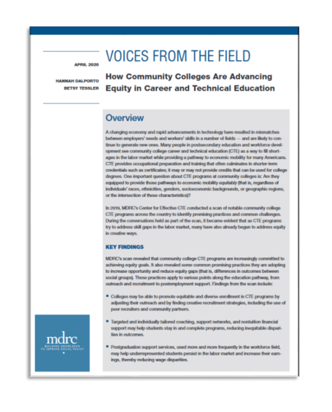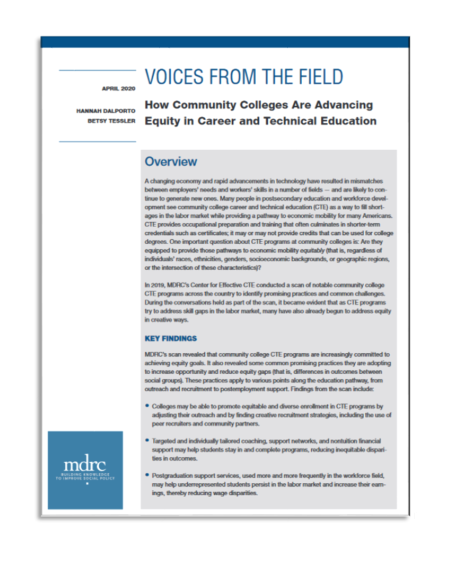How Community Colleges Are Advancing Equity in Career and Technical Education
April 06, 2020
 By Hannah Dalporto and Betsy L. Tessler, MDRC
By Hannah Dalporto and Betsy L. Tessler, MDRC
A changing economy and rapid advancements in technology have resulted in mismatches between employers’ needs and workers’ skills in a number of fields — and are likely to continue to generate new ones. Many people in postsecondary education and workforce development see community college career and technical education (CTE) as a way to fill shortages in the labor market while providing a pathway to economic mobility for many Americans. CTE provides occupational preparation and training that often culminates in shorter-term credentials such as certificates; it may or may not provide credits that can be used for college degrees. One important question about CTE programs at community colleges is: Are they equipped to provide those pathways to economic mobility equitably (that is, regardless of individuals’ races, ethnicities, genders, socioeconomic backgrounds, or geographic regions, or the intersection of these characteristics)?
In 2019, MDRC’s Center for Effective CTE conducted a scan of notable community college CTE programs across the country to identify promising practices and common challenges. During the conversations held as part of the scan, it became evident that as CTE programs try to address skill gaps in the labor market, many have also already begun to address equity in creative ways.
Key Findings
MDRC’s scan revealed that community college CTE programs are increasingly committed to achieving equity goals. It also revealed some common promising practices they are adopting to increase opportunity and reduce equity gaps (that is, differences in outcomes between social groups). These practices apply to various points along the education pathway, from outreach and recruitment to postemployment support. Findings from the scan include:
- Colleges may be able to promote equitable and diverse enrollment in CTE programs by adjusting their outreach and by finding creative recruitment strategies, including the use of peer recruiters and community partners.
- Targeted and individually tailored coaching, support networks, and nontuition financial support may help students stay in and complete programs, reducing inequitable disparities in outcomes.
- Postgraduation support services, used more and more frequently in the workforce field, may help underrepresented students persist in the labor market and increase their earnings, thereby reducing wage disparities.
- As colleges continue to become more sensitive to equity goals, they can aim to uncover otherwise hidden inequities by analyzing outcomes according to race, ethnicity, gender, and other characteristics relevant to their local contexts.
 Read the brief here.
Read the brief here.
